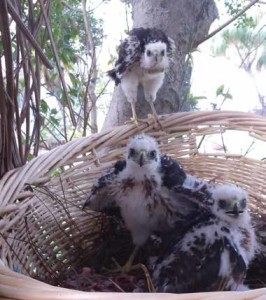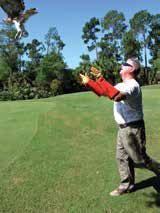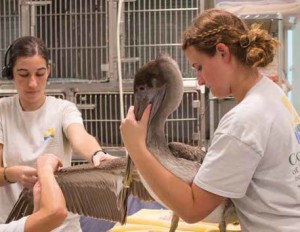Conservancy Update December 2015
 It is 7:35 a.m. when the first patient shows up, one of nearly a dozen that day at the von Arx Wildlife Hospital of the Conservancy of Southwest Florida. Driven from the Naples Pier by two caring volunteers, the large brown pelican has ingested a fishhook and is urgent need of care. The bird is otherwise healthy and alert – a good candidate for rehabilitation and release.
It is 7:35 a.m. when the first patient shows up, one of nearly a dozen that day at the von Arx Wildlife Hospital of the Conservancy of Southwest Florida. Driven from the Naples Pier by two caring volunteers, the large brown pelican has ingested a fishhook and is urgent need of care. The bird is otherwise healthy and alert – a good candidate for rehabilitation and release.
The animal recovery clinic had its origins in the distant past, part of the Big Cypress Nature Center, run in afternoons by students in the Junior Audubon program. While its reputation grew, treatment facilities did not until the modern-day Conservancy merged with the Center when, with support from committed donors, a more spacious and modern facility was constructed. With birds, animals and reptiles pouring through the front door, concern with rabies and other diseases required a cadre of trained volunteers to handle the ever-increasing case load.
Julie Wasserman was the first director, setting the organization up with a streamlined admissions and evaluation process.
 Over four acres of flight cages were built to exercise wounded birds and help them regain strength, followed by enclosures to acclimate recovering mammals to southwest Florida’s ever-changing weather, and a pool to test the diving skills of rehabilitated turtles – all in anticipation of the day of release when the creature could by Nick Penniman I run, fly or crawl back into its natural environment as close to the wounded creature’s pick-up point as possible. Outdoor facilities were also built to house residents – mainly birds unable to reach a satisfactory level of recovery to be released back into the wild – among the more notorious being a bossy and assertive affectionately nicknamed, Edgar Allen Crow, who vigorously resisted any attempt to have his enclosure cleaned.
Over four acres of flight cages were built to exercise wounded birds and help them regain strength, followed by enclosures to acclimate recovering mammals to southwest Florida’s ever-changing weather, and a pool to test the diving skills of rehabilitated turtles – all in anticipation of the day of release when the creature could by Nick Penniman I run, fly or crawl back into its natural environment as close to the wounded creature’s pick-up point as possible. Outdoor facilities were also built to house residents – mainly birds unable to reach a satisfactory level of recovery to be released back into the wild – among the more notorious being a bossy and assertive affectionately nicknamed, Edgar Allen Crow, who vigorously resisted any attempt to have his enclosure cleaned.
By 2010 the clinic had outgrown itself again, handling up to 3,000 cases a year. After a leadership gift from the von Arx Family Foundation, a new facility arose – a modern 5,000 sq. ft. hospital with X-ray and surgery suite run by a veterinarian, Dr. PJ Deitschel and four full-time staffers, supplemented with a corps of student interns. The hospital is now open 365 days a year from 7:30 a.m. to 9 p.m. supported by the efforts of nearly one hundred dedicated volunteers critical to the success of the year-round operation.
 “We rely heavily upon the public and our volunteers to bring the animals in,” said Joanna Fitzgerald, the hospital’s director for the last decade. Those who answer the phones are trained to talk through how to capture and secure wounded birds and animals, and transport them safely, she said.
“We rely heavily upon the public and our volunteers to bring the animals in,” said Joanna Fitzgerald, the hospital’s director for the last decade. Those who answer the phones are trained to talk through how to capture and secure wounded birds and animals, and transport them safely, she said.
“As we expand to the east in Collier County, we have many more human interactions with the residents of the natural world, so we have to rely upon the good will of people to bring them to us.”
The hospital will handle about 3,600 cases in 2015 – one of which is our brown pelican now X-rayed and being prepped to have the fishhook removed. The bird’s pouch is slightly damaged, but with antibiotics (or perhaps an herbal cure) should make a full and complete recovery.
But it’s not all about rescue and rehabilitation says Fitzgerald: “It’s also about education. What a great opportunity we have here to create empathy between humans and other living creatures that share the planet with us. That’s a big part of our commitment.”
If you find injured wildlife in the Southwest Florida area, call the Conservancy’s von Arx Wildlife Hospital at 239.262.2273.
1495 Smith Preserve Way, Naples, FL www.conservancy.org/wildlife

Leave a Reply
Want to join the discussion?Feel free to contribute!